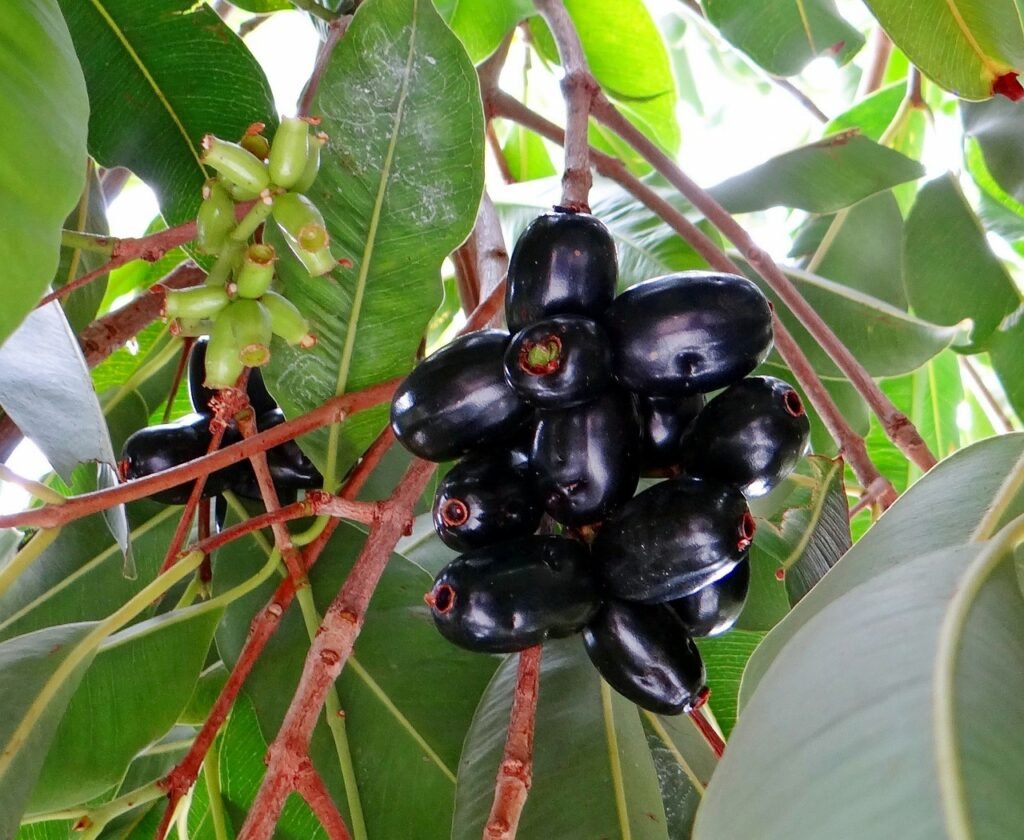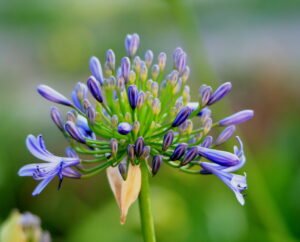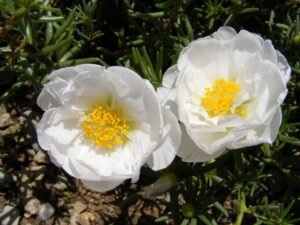How To Plant, Grow, And Care For Java Plum

Java Plum Tree
Syzygium cumini, commonly known as the Java plum, is a tropical fruit tree indigenous to the Indian subcontinent. Java plum has many common names such as Jaman, Jamun, Java Plum, Black Plum, Malabar Plum, Jambul, or Jambolan . It is a popular evergreen tropical fruit-bearing tree for home gardens and provides not only delicious fruits but also shade and beauty to your outdoor space. This article explains in detail how to plant, grow, And care For Java Plum Tree.

The java plum tree is native to the Indian subcontinent, including India, Bangladesh, Nepal, and Sri Lanka. It has also been introduced to other tropical regions around the world, such as Southeast Asia, Africa, and the Americas. The tree thrives in warm and humid climates and can be found in both wild and cultivated settings.
Facts About Java Plum Tree
Java plum holds cultural significance in many regions where it is grown. In India, the fruit is associated with Lord Krishna and is often offered to deities during religious ceremonies. The tree is considered sacred and is believed to possess spiritual and healing powers.
The Java Plum is an evergreen tree that can grow up to 30 meters in height. It produces tiny, fragrant white blooms and lustrous, dark green foliage. The fruit of the Java Plum is round and varies in color from dark purple to black.
The java plum fruit is small to medium-sized, with a smooth, dark purple or black skin. It has a sweet and tangy taste, similar to a combination of plums and cherries. The flesh is juicy and contains a single seed in the center. The fruit is often used in jams, jellies, desserts, and beverages.
Java plum is not only delicious but also packed with essential nutrients. It is a good source of vitamins A and C, as well as minerals like calcium, iron, and potassium. It also has a lot of antioxidants, which lower the chance of developing chronic illnesses and shield the body from oxidative stress.
Java plum is a versatile fruit that can be used in a variety of culinary preparations. It is commonly used in making jams, jellies, and preserves. The fruit can also be used in desserts like pies, tarts, and cakes. In some regions, the ripe fruit is fermented to make a delicious alcoholic beverage called “jambul wine.” Additionally, the leaves of the java plum tree are often used in cooking as a flavoring agent.
FAQ About Java Plum Tree
How long does it take for java plum to fruit?
When it comes to fruiting, the Java Plum tree typically takes around 6 to 8 years to start producing fruits. However, this timeline can vary depending on various factors such as the growing conditions, climate, and the specific variety of the tree.
How tall does a Java Plum Tree grow?
A Java Plum Tree can grow up to 30 meters in height, making it a medium-sized tree. However, it is possible to control its growth through pruning and shaping techniques.
Can I grow a Java Plum Tree in a container?
Yes, it is possible to grow a Java Plum Tree in a container. However, it is important to choose a large container with good drainage and provide proper care, including regular watering, fertilization, and pruning.
Right Location For Java Plum Tree
Before you start planting your Java plum tree, it is important to choose the right location. Java plum trees thrive in warm and tropical climates, so make sure you live in an area with a suitable climate. The tree requires full sun to grow and produce abundant fruits, so choose a spot in your garden that receives at least 6-8 hours of direct sunlight every day.
Additionally, Java plum trees prefer well-draining soil. If your soil is heavy and clayey, consider improving its drainage by adding organic matter such as compost or well-rotted manure. This will help prevent waterlogged conditions that can lead to root rot.
Java plums have a strong root system that can cause trouble to the foundation of your home, so they should be planted at least 20 feet away from the home foundation.
How To Plant Java Plum Tree
Once you have selected the right location, it’s time to plant your Java plum tree. Follow these steps:
- Start by digging a hole that is twice as wide and deep as the tree’s root ball.
- Take care not to damage the tree’s roots as you carefully remove it from its container.
- Place the tree in the center of the hole and backfill with the excavated soil, firming it gently around the roots.
- Water the newly planted tree thoroughly to settle the soil and eliminate any air pockets.
- Apply a layer of organic mulch around the base of the tree, leaving a gap around the trunk to prevent moisture-related diseases.
How To Care For Java Plum Tree
Watering
Proper watering and fertilizing are crucial for the healthy growth and fruit production of your Java plum tree.
Water the tree regularly, especially during dry spells or when the tree is young and establishing its root system. The soil should be kept continuously moist but not soggy. Deep watering once a week is usually sufficient, but adjust the frequency based on your local climate and soil conditions.
Fertilizing
When it comes to fertilizing your Java Plum trees, it is crucial to choose the right fertilizer that provides the necessary nutrients for healthy growth. Look for a balanced fertilizer with a ratio of nitrogen (N), phosphorus (P), and potassium (K) such as a NPK 10-10-10 or 14-14-14.
Additionally, consider using organic fertilizers such as compost or well-rotted manure. Organic fertilizers not only provide nutrients but also improve soil structure and enhance the overall health of the tree.
The application rate of fertilizer for Java Plum trees depends on the age and size of the tree. Young trees require less fertilizer compared to mature ones. As a general guideline, apply 1/4 pound of fertilizer per inch of trunk diameter for trees less than 3 years old. For older trees, apply 1/2 pound of fertilizer per inch of trunk diameter.
Measure the diameter of the trunk at about 6 inches above the ground level to determine the amount of fertilizer needed. Avoid applying excessive amounts of fertilizer as it can lead to nutrient imbalances and harm the tree.
The timing of fertilizer application is crucial for the optimal growth of Java Plum trees. It is best to apply fertilizer in early spring, just before the start of the growing season. This allows the tree to absorb the nutrients and utilize them for healthy growth.
Avoid fertilizing during periods of drought or extreme heat, as the tree may not be able to efficiently absorb the nutrients. Also, refrain from fertilizing in late fall or winter when the tree is dormant.
Pruning and Training
Pruning is an essential part of caring for your Java plum tree. Regular pruning helps maintain the tree’s shape, promotes airflow, and removes dead or diseased branches.
Start pruning your Java plum tree when it is young to establish a strong framework. Remove any crossing or rubbing branches and maintain an open center to allow sunlight to reach all parts of the tree.
It is best to prune in the dormant season, which is often late winter or early spring, before new growth appears. Avoid heavy pruning during other times of the year, as it can reduce fruit production.
Pest and Disease Control
Java plum trees are generally resilient to pests and diseases, but they can still be susceptible to certain issues. The following are some common diseases and pests to be aware of:
- Fruit fly: Use fruit fly traps or organic insecticides to control fruit fly infestations.
- Anthracnose: This fungal disease can cause fruit rot. Ensure good airflow around the tree and remove any infected fruits or branches.
- Root rot: Avoid overwatering and ensure proper drainage to prevent root rot.
Regularly inspect your tree for any signs of pests or diseases, and take appropriate measures to control them if necessary. Consult with a local gardening expert or extension service for specific recommendations based on your region.
By following these guidelines, you can successfully plant, grow, and care for your Java plum tree. With proper attention and care, you will be rewarded with delicious fruits and a beautiful addition to your garden. Enjoy the process and the bountiful harvest!





